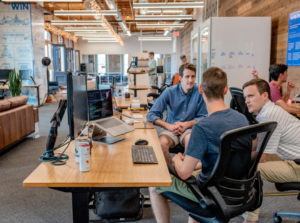 If your team has mostly or completely worked remote during the pandemic, you’re not (no pun intended) alone. McKinsey estimated that almost two-thirds of employees worked remotely during this time, versus 25% a couple of years ago – and 80% reported that they enjoy working from home. Most feel they can be more productive, or at least just as productive, at home as they are at the office.
If your team has mostly or completely worked remote during the pandemic, you’re not (no pun intended) alone. McKinsey estimated that almost two-thirds of employees worked remotely during this time, versus 25% a couple of years ago – and 80% reported that they enjoy working from home. Most feel they can be more productive, or at least just as productive, at home as they are at the office.
Technology may do a great job facilitating remote productivity, and even some camaraderie through Zoom meetings and Slack chats, but many people will tell you they would like to have, at the very least, a hybrid option where they can come in to the office to collaborate formally and informally with their colleagues in person. And while every organization and every person is different, many companies will be looking for ways to facilitate this hybrid option, or even full-time back-to-work arrangements.
If you’re part of a leadership team tasked with giving employees the news that they should, or must, come back to the office, how can you get them to greet this news positively? And what infrastructure should you put in place to facilitate their collaboration – as well as ensure they enjoy coming to the office, rather than sending their resume to that fully remote competitor of yours?
Here are a few things we’ve seen our clients focusing on:
Safety. Consideration for your employees’ safety at the workplace should always be a cornerstone of your culture. What makes your employees comfortable in closer quarters will depend on your regional rates of transmission, but companies are implementing a variety of safety strategies ranging from vaccine and mask requirements when in compliance with local laws, financial incentives for vaccinations, larger and individual offices, improved ventilation systems, enhanced disinfection protocols, ubiquitous hand sanitizer stations and more. If many of your workers used public transit, you may now need to lease additional parking spaces or add bike racks to your office space until they are comfortable with buses and trains again. And keep in mind that “best practices” in this area will be ever-changing – after initially relaxing guidelines, we’ve already seen large companies need to be nimble in re-implementing more stringent safety protocols here, including reissuing mask mandates and one large US employer which had begun welcoming workers back to the office but recently sent notifications to workers in high areas of transmission encouraging a return to telework after the emergence of the COVID-19 Delta variant.
Structure. If collaboration and collegiality are the key benefits that companies and employees cite for returning to the office, it makes sense to put in frameworks to ensure these things can happen. Hybrid arrangements should ensure a core set of days, or hours, for cross-functional teams to be in the office in person, as well flexible meeting spaces for their use. For some companies, this is a full refresh of their office footprint – including locations – and there is no one-size-fits-all answer; some might be better served giving up big-city office space for suburban locations convenient to their teams, while for others, this is the ideal opportunity to leave a suburban office park for a previously unaffordable space in the city, or to move to coworking space with flexible meeting rooms.
Amenities. Some workers in big cities will be elated simply to leave the cramped desk in a corner of their bedroom behind and get back into a real workspace, but many people who could afford to do so moved to larger spaces during the pandemic, and may have spent the last year and a half working with pool or lake views, their dog at their feet, wearing comfortable clothing and sleeping in to take full advantage of zero commute. What do they want when they get back to the office? Startup culture has regularly provided many employee perks like baristas and catered meals, and on-site dry cleaning. On-site daycare (or doggie daycare) and gyms (just as convenient as hitting the Peloton at lunch) may increase convenience. Or combine entertainment and camaraderie – one building near our Orlando office is partnering with TopGolf to offer suites in its shared area, along with meeting and catering space. And a building in Utrecht, Netherlands, has embraced biophilic design by adding a park – replete with a stream – to their tower as a place for workers to let the outside in.
An honest assessment of your office culture, and what your employees enjoy and what will best bring them together in a safe, productive and collaborative way should start with these fundamental pillars. With thoughtful programming and design, you can embrace many of the concepts they’ve come to value from working remotely, deliver time-saving services that make up for things you can’t change like their commutes and remind them of the things they enjoy about in-person collaboration and community.